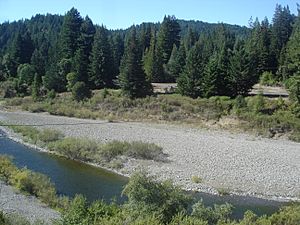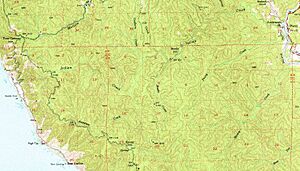Andersonia, California facts for kids
Quick facts for kids
Andersonia
|
|
|---|---|

Little remains of Andersonia at the confluence of Indian Creek and the South Fork Eel River.
|
|
| Country | United States |
| State | California |
| County | Mendocino County |
| Elevation | 541 ft (165 m) |
Andersonia is a small, undeveloped area in Mendocino County, California. It's not a city or town with its own government. Instead, it's an "unincorporated community." This means it's a place where people live, but it's managed by the county government. Andersonia is located near U.S. Route 101, close to the South Fork of the Eel River. It's about 1 mile (1.6 km) north-northwest of Piercy. The area sits at an elevation of 541 feet (165 meters) above sea level.
Contents
History of Andersonia
| Overview | |
|---|---|
| Headquarters | Andersonia, California |
| Reporting mark | ? |
| Locale | Andersonia, California |
| Dates of operation | 1893–1921 |
| Technical | |
| Track gauge | ? |
Andersonia's story began with logging. In 1884, a small dock was built at Bear Harbor. This dock was used to load timber products from the nearby forests.
In 1893, work started on the Bear Harbor and Eel River Railroad. This railway was built to connect Bear Harbor to Indian Creek. Indian Creek is a small stream that flows into the South Fork Eel River. The end of the railway inland was called Moody. This name came from Lew Moody, who built a hotel and saloon there.
The Sawmill and Its Names
A large sawmill was built in 1903. It was called Southern Humboldt Lumber Company camp 10. This location was named Andersonia after the company's president, Henry Neff "Pap" Anderson. A special dam was built on Indian Creek to create a log pond. This pond could hold 20 million board feet of timber. This timber was waiting to be cut into lumber at the mill. By 1905, a 17-mile (27 km) railway extension from Moody to Andersonia was finished.
Sadly, "Pap" Anderson passed away in a mill accident on November 6, 1905. Because of this, the sawmill's operation was delayed. Mr. and Mrs. Lilley stayed on as caretakers of the quiet town.
In April 1906, the mill was almost sold to a company from Michigan. However, a big earthquake on April 18 caused the buyer to change their mind.
Closing and Reopening
In 1921, the mill, its equipment, and all machinery were taken apart. They were put into storage, and the town was officially closed.
Heavy rains in 1925 and 1926 caused the dam to break. This sent all the old logs, which had been stored for twenty years, floating down the Eel River.
Years later, Anderson's grandsons brought new life to the mill. They started a company called "Andersonia Forest Products." Later, the company name changed to Indian Creek Lumber Company. In 1950, it changed back to Andersonia Forest Products. A new manager, Tom Dimmick, took over. Lumber was then transported by trucks using U.S. Route 101. They did not rebuild the old railroad or the dock at Bear Harbor.
The old locomotives from the railroad were saved in 1962. The sawmill kept running until 1972. By then, all the local timber supplies had been used up.
Bear Harbor and Eel River Railroad Locomotives
These are the locomotives (train engines) that were used on the Bear Harbor and Eel River Railroad:
| Number | Builder | Type | Date | Works number | Notes |
|---|---|---|---|---|---|
| 1 | Marshutz and Cantrell | 0-4-0 Tank locomotive | 1892 | This engine was bought new. It has been restored and is now at Fort Humboldt State Historic Park. | |
| 2 | Baldwin Locomotive Works | 2-4-2 Tank locomotive | 1898 | This engine was also bought new. It is also preserved at Fort Humboldt State Historic Park. |
See also
 In Spanish: Andersonia (California) para niños
In Spanish: Andersonia (California) para niños



